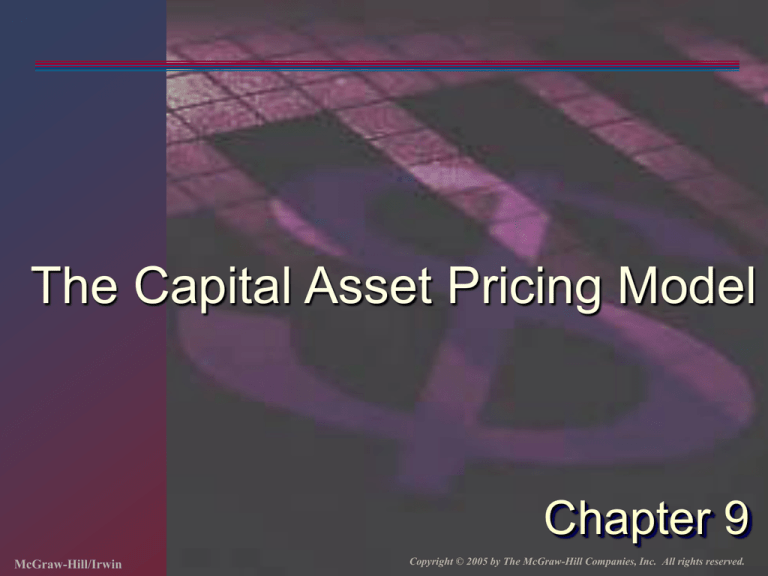
The Capital Asset Pricing Model
Chapter 9
McGraw-Hill/Irwin
Copyright © 2005 by The McGraw-Hill Companies, Inc. All rights reserved.
Capital Asset Pricing Model (CAPM)
It is the equilibrium model that underlies all
modern financial theory.
Derived using principles of diversification
with simplified assumptions.
Markowitz, Sharpe, Lintner and Mossin are
researchers credited with its development.
9-2
Assumptions
Individual investors cannot affect prices by
their individual trades.
Single-period investment horizon.
Investors form portfolios from many publicly
traded financial assets.
They can borrow at Rf and have unlimited
borrowing and lending opportunities
No taxes and transaction costs.
9-3
Assumptions (cont’d)
Information is costless and available to all
investors.
Investors are rational mean-variance optimizers.
They attempt to construct Markowitz’s efficient
frontier.
There are homogeneous expectations. All
investors analyse the securities in the same way
and share the same economic view of the world.
All investors use the same expected return,
standard deviations, and correlations to generate
the efficient frontier and the unique optimal risky
portfolio.
9-4
Resulting Equilibrium Conditions
1. The proportion of the each security in all
investors porfolios will be same as the
proportion of each security in the market
porfolio (consists of all securities in the
market).
All investors will hold the same portfolio for
risky assets – market portfolio.
Market portfolio contains all securities and
the proportion of each security is its market
value as a percentage of total market value.
9-5
Resulting Equilibrium Conditions
2. The market portfolio will be on the efficient
frontier. It will be the optimal port, the
tangency point of the CAL to the efficient
frontier. As a result CML, the line from the rf
through the market port, M is also the best
attainable CAL.
All investors hold M as the optimal risky
portfolio, differing only in the amount
invested in it as compared to investment in
risk-free asset.
9-6
Resulting Equilibrium Conditions (cont’d)
3.The risk premium on the market portfolio will be
proportional to its risk and the degree of the
average risk aversion of all market participants.
E ( Rm ) r f A m2 .01
While M is the efficient diversified optimal portfolio,
unsystematic risk is eliminated, market variance
denote just the systematic risk.
9-7
4. Risk premium on an individual security is a
function of its covariance with the market.
The risk premium on individual assets will be
proportional to the risk premium on the
market portfolio and the beta coefficient of the
security on the market port. Beta measures
the extent to which returns on the stock and
the market move together.
9-8
i
Cov(ri , rm )
m2
Cov(ri , rm )
E (ri ) rf
E (rm ) rf i E (rm ) rf
2
m
9-9
Capital Market Line
E(r)
E(rM)
M
CML
rf
m
9-10
Slope and Market Risk Premium
M
rf
E(rM) - rf
=
=
=
Market portfolio
Risk free rate
Market risk premium
E(rM) - rf
=
Market price of risk
=
Slope of the CAPM
M
9-11
Why all investors would hold the Market Portfolio?
With the these assumptions, investors
all must arrive at the same
determination of the optimal risky
portfolio. They all derive identical
efficient frontiers and find the same
portfolio for the CAL from T-bills to the
frontier.
9-12
If the weight of GM stock in each common
risky port is 1%, then GM also will comprise
1% of the market portfolio. The same
principle applies to the proportion of any
stock in each investor’s risky portfolio. As a
result, the optimal risky port of all investors is
simply a share of the market portfolio.
Because each investor has the market
portfolio for the optimal risky portfolio the CAL
is called the CML
9-13
Now suppose that the optimal portfolio of the our
investors does not include the stock of say Delta Air
Lines when no investor is willing to had Delta stock,
the demand is zero, and the stock price will fall. As
Delta stock gets cheaper, it begins to look more
attractive, while all other stocks look less attractive.
Delta will reach a price at which it is desirable to
include it in the optimal portfolio and all investors will
buy. This price adjustment process guarantees that
all stocks will be included in the optimal portfolio. The
only issue is the price. If all investors had an identical
risk portfolio, this portfolio must be the market
portfolio.
9-14
The Passive Strategy is Efficient
The passive strategy, using the CML as the
optimal CAL, is a powerful alternative to an
active strategy. In the simple world of CAPM,
all investors use precious resources in
security analysis. A passive investor’s
investing in the market portfolio benefits from
the efficiency of that portfolio. An active
investor who chooses any other portfolio will
end on a CAL that is less efficient than the
CML.
9-15
Mutual Fund Theorem
Only one mutual fund of risky assets –
the market portfolio- is enough to satisfy
the investment demand of all investors.
All investors agree that the mutual fund
theorem is that a passive investors may
view the market index as a reasonable
first approximation to an efficient risky
portfolio.
9-16
The Risk Premium of the Market Portfolio
The equilibrium risk premium of the market
portfolio will be proportional to the degree of
average A and σm2.
E (rm ) r f A m2 .01
Each individual investor chooses a proportion
y, allocated to the optimal portfolio, M such
that;
E (r ) r
y
m
f
A m2 .01
9-17
The Risk Premium of the Market Portfolio
In the simplified CAPM economy, risk free
investments involve borrowing and lending
among investors. Any borrowing position
must be offset by the lending position. This
means that net borrowing and lending across
all investors must be zero and the average
position in the risky portfolio is 100 %, y = 1.
Setting y = 1 to equation above;
2
E (rm ) r f A m
.01
9-18
Expected Returns on Individual Securities
The contribution of one stock to the portfolio
variance can be expressed as the sum of all
the covariance terms.
For example the contribution of GM stock to
the variance of the market portfolio is:
wGM w1Cov(r1 , rGM ) w2Cov(r2 , rGM ) ..... wGM Cov(rGM , rGM ) .... wn Cov(rn , rGM )
9-19
Expected Returns on Individual Securities
We can best measure the stock’s
contribution to the risk of the market
portfolio by its covariance with the
market portfolio
GM’s contr to mrk variance = wGMCov(rGM,rm)
9-20
Expected Returns on Individual Securities
The reward-to-risk ratio for investments
in GM;
GM’s contribution to the risk premium/
GM’s contribution to the variance
wGM E (rGM ) r f
E(r
wGM Cov(rGM , rm )
GM
) rf
Cov(rGM , rm )
9-21
Expected Returns on Individual Securities
The market port is the tangency
(efficient mean-variance) port. The
reward-to-risk ratio for investment in the
market port.
Market risk premium/market variance
(Market price of risk) = E ( rm ) r f
m2
9-22
Expected Returns on Individual Securities
A basic principal of equilibrium is that all
investments should offer the same
reward-to-risk ratio. So that the rewardto-risk ratios of GM and the market port
should be equal;
E (r
GM
) rf
E (r
Cov(rGM , rm )
m
) rf
m2
9-23
Expected Returns on Individual Securities
E (rGM ) r f
Cov(rGM , rm )
2
m
E (r
E (rGM ) r f GM E (rm ) r f
m
) rf
This is expected return and beta
relationship which is the expression of
the CAPM.
9-24
Security Market Line
We can view the expected return and beta
relationship in a reward-risk equation. The beta of a
security is the appropriate measure of its risk
because beta is proportional to the risk the security
contributes to the optimal risky.
We would expect the reward (risk premium) on
individual assets, to depend on the risk an individual
asset contributes to the overall portfolio. Because the
beta of a stock measures the stock’s contribution to
the variance of the market portfolio, we expect the
required risk premium to be a function of beta.
Security’s risk premium is directly proportional to both
the beta and the risk premium of the market portfolio.
9-25
Security Market Line
E(r)
SML
E(rM)
rf
M = 1.0
9-26
SML Relationships
= [COV(ri,rm)] / m2
Slope SML = E(rm) - rf
= market risk premium
SML = rf + [E(rm) - rf]
Betam = [Cov (rm,rm)] / m2
= m2 / m2 = 1
9-27
Sample Calculations for SML
E(rm) - rf = .08 rf = .03
x = 1.25
E(rx) = .03 + 1.25(.08) = .13 or 13%
y = .6
E(ry) = .03 + .6(.08) = .078 or 7.8%
9-28
Graph of Sample Calculations
E(r)
SML
Rx=13%
.08
Rm=11%
Ry=7.8%
3%
.6
y
1.0
1.25
x
9-29
Differences between CML and SML
The CML graphs the risk premiums of efficient
portfolios (ports composed of market and risk free
asset) as a function of portfolio standard deviation.
This is appropriate because standard deviation is a
valid measure of risk for efficiently diversified
portfolios that are candidates for an investor’s overall
portfolio.
The SML graphs the risk premium of individual assets
as a function of asset risk. The relevant measure of
risk for individual assets is not the asset’s standard
deviation instead the contribution of the asset to the
portfolios standard deviation as measured by the
asset’s beta. The SML is valid both for portfolios and
individual assets.
9-30
Disequilibrium Example
E(r)
SML
15%
Rm=11%
rf=3%
1.0
1.25
9-31
Disequilibrium Example (cont.)
Suppose a security with a of 1.25 is offering
expected return of 15%. (Actually expected
return)
According to SML, it should be 13%. (Fair
Expected Return)
Under-priced: offering too high of a rate of
return for its level of risk.
α (Alpha) = 15%-13%=2% (positive for cheap
securities).
9-32
Black’s Zero Beta Model
Absence of a risk-free asset: When
investors can not borrow at rf, they may
choose risky portfolios from the entire
set of efficient frontier portfolios
according to how much risk they choose
to bear.
The market is no longer the common
optimal portfolio.
9-33
Black’s Zero Beta Model
An equilibrium expected return-beta relationship in the
case of restrictions on risk free has been developed by
Fischer Black.
Black’s model of the CAPM in the absence of risk free
rests on 3 properties of mean-variance efficient ports.
Combinations of portfolios on the efficient frontier are
efficient.
All frontier portfolios have companion portfolios (on the
bottom half-the inefficient part) that are uncorrelated.
Because the portfolios are uncorrelated, the
companion portfolio is referred to as the zero-beta
portfolio of the efficient frontier portfolio.
Returns on individual assets can be expressed as
linear combinations of efficient portfolios.
9-34
Black’s Zero Beta Model Formulation
E (ri ) E (rQ ) E (rP ) E (rQ )
Cov(ri , rP ) Cov(rP , rQ )
P2 Cov(rP , rQ )
9-35
Efficient Portfolios and Zero Companions
E(r)
Q
P
E[rz (Q)]
E[rz (P)]
Z(Q)
Z(P)
9-36
Zero Beta Market Model with Rf Lending but not Borrowing
We can express express the return on any security
in terms of M and Z (M) where P has been replaced
by M, Q has been replaced by Z(M) and rf has
been replaced with E(rZ(M)) as;
Cov(ri , rM )
E (ri ) E (rZ ( M ) ) E (rM ) E (rZ ( M ) )
2
M
CAPM with E(rz (m)) replacing rf
Cov(rM,rZ(M))=0
9-37







